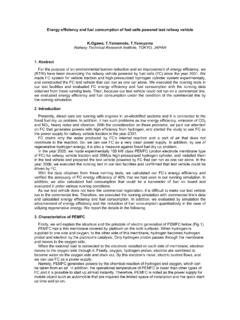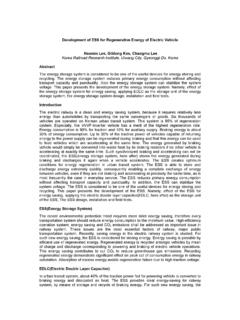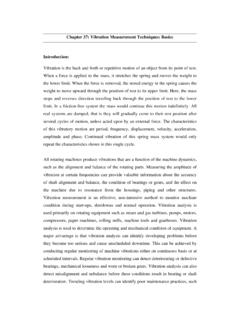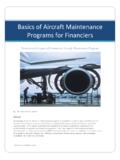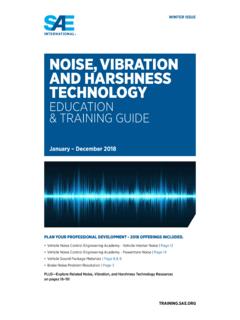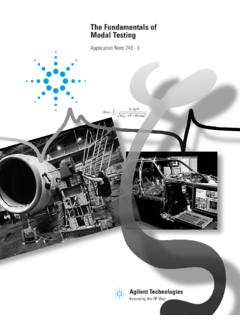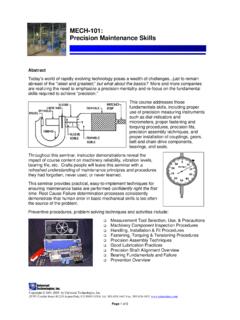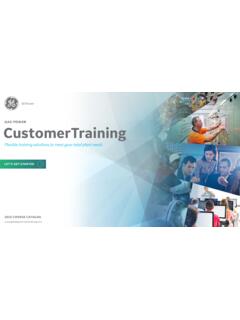Transcription of Track Buckling Hazard Detection and Rail Stress …
1 Challenge C: Increasing Freight capacity and services 1 Track Buckling Hazard Detection and rail Stress M anagement ABSTRACT A key aspect of managing the Stress state of the railroad involves controlling longitudinal rail stresses to safe levels. rail networks are therefore focused on reducing the risk of both buckled Track and broken rail for safety and security enhancement. The efficient management of longitudinal Stress induced thermal forces in continuous welded rail (CWR) is an important aspect of railroad safety and maintenance. Balancing such forces is a complex issue which requires intimate knowledge of many parameters which include Track strength as well as environmental operating conditions.
2 CWR Track is prone to lateral Buckling when the rails are under high compressive forces. Conversely, when high tensile forces dominate under cold temperature conditions, rail defect growth can cause rail fractures, weld failures and rail joints to pull apart. The magnitude of longitudinal thermal forces is governed by the rail neutral temperature (RNT) which is the rail temperature at which the net force is zero. It is well known that RNT is a highly variable parameter and that its measurement has proven to be both difficult and costly. This paper presents evolving and proven measurement technologies as well as new safety tools for longitudinal force management .
3 The safety aspects include Track Buckling prevention through Hazard identification diagnostics in terms of a yellow , orange and red Buckling margin of safety (BMS) warning, and rail break Detection through sudden Stress discontinuity (interruption) measurements. The maintenance aspects include providing and applying data for rail defect/break repairs when readjusting RNT to safe values in various operation conditions, and providing data for curve realignment and stability improvement through more efficient RNT management . The applications are illustrated through case study examples. Introduction Prevention of excessive longitudinal thermal forces in continuous welded rail (CWR) is an important Track maintenance and safety issue.
4 Thermal forces are generated when the rail temperature varies from the rail s neutral temperature (RNT) the rail temperature at which the longitudinal force is zero, which is typically the rail s installation or fastening temperature. (Note: common terminology also uses SFT and TN to designate RNT). Compressive forces are produced when the rail temperature is higher than the RNT, and tensile forces are produced when the rail temperatures are below the RNT. High compressive forces can cause Track Buckling , while high tensile forces can accelerate rail defect growth and cause rail joints to fail or pull apart in cold weather, with both being potential derailment causes.
5 Longitudinal forces are controlled by installing and maintaining the rail at RNT levels within specified limits. However, it is a well known fact that the RNT will vary over time and that it typically shifts to a lower value that can increase the risk of Track Buckling . These lowered RNT values can result from rail repair or Andrew Kish, Consulting ServicesPeabody, MA, USAP hone: 978-535-3342 Email: S. McWilliamsVice President-Technology & Business DevelopmentSalient Systems, Dublin, OH, USAP hone: 719-337-5852 Email: HarrisonSalient Systems -Technology ConsultantFriday Harbor, WA, USAP hone: 360-317-8505 Email: Kish, Consulting ServicesPeabody, MA, USAP hone: 978-535-3342 Email: S.
6 McWilliamsVice President-Technology & Business DevelopmentSalient Systems, Dublin, OH, USAP hone: 719-337-5852 Email: HarrisonSalient Systems -Technology ConsultantFriday Harbor, WA, USAP hone: 360-317-8505 Email: C: Increasing Freight capacity and services 2other maintenance work undertaken during cold weather and from excessive rail movement. A key impediment to knowing these low and potentially dangerous RNTs is a lack of adequate measurement capability which has eluded researchers for the past three decades. There have been several measurement concepts/techniques proposed and evaluated over the years with mixed results.
7 These included techniques based on various physics concepts as illustrated in Figure 1. Figure 1 Summary of RNT Measurement Concepts The key compromising aspects being (1) measurement accuracy, (2) ease of deployment, (3) providing continuous data on a real time basis, and (4) having direct applicability to railroad maintenance and safety. Although several concepts partially fulfill these needs, the US Salient System s rail Stress Monitor (RSM) and its supportive StressNetTM data base system have evolved to be the most responsive to the above needs. The RSM and its Stress NetTM technology have been developed and tested over twenty-five years of R&D, and have been recently expanded to support specific industry needs to not only measure RNT but interpret it for practical application to enhance overall CWR safety and performance.
8 More specifically the RSM and StressNetTM technology: Measures longitudinal force and RNT Detects rail breaks and Track buckles Alerts on potential Buckling hazards Enables more effective rail break/defect repairs Monitors rail joint condition In this paper several of these applications will be discussed with a particular emphasis on Track Buckling prevention through potential Hazard identification diagnostics in terms of a green , yellow , orange or red Buckling Hazard warning. The RSM-StressNetTM System (The RSM Technology) The rail -mounted hardware represents continuing evolving technology developments starting with a Stress measurement circuit first developed at Battelle Columbus Laboratories in the early eighties [1, 2, RNT Measurement Concepts/Issues Mechanical/electrical resistance strain gage rail uplift Vibrating wire/filament Ultrasonic wave Magnetic permeability:(Barkhausennoise)(Magnetost riction) Acoustic wave rail vibration Electromagnetic/acoustic wave (EMAT)Concepts Researched X-ray diffraction AccuracyIssues:sensitivity to railmicrostructure, residualstresses, Track parameters.]
9 Hard to get force/RNT fromstress; zeroes required Don t provide real-time, continuous data output Not nondestructive andnot easily deployableMeasurement Difficulties No direct applicability to railroad maintenance and safety practicesRNT Measurement Concepts/Issues Mechanical/electrical resistance strain gage rail uplift Vibrating wire/filament Ultrasonic wave Magnetic permeability:(Barkhausennoise)(Magnetost riction) Acoustic wave rail vibration Electromagnetic/acoustic wave (EMAT)Concepts Researched X-ray diffraction Mechanical/electrical resistance strain gage rail uplift Vibrating wire/filament Ultrasonic wave Magnetic permeability:(Barkhausennoise)(Magnetost riction) Acoustic wave rail vibration Electromagnetic/acoustic wave (EMAT)Concepts Researched X-ray diffraction AccuracyIssues:sensitivity to railmicrostructure, residualstresses, Track parameters; hard to get force/RNT fromstress; zeroes required Don t provide real-time, continuous data output Not nondestructive andnot easily deployableMeasurement Difficulties No direct applicability to railroad maintenance and safety practicesChallenge C: Increasing Freight capacity and services 33], and culminating in today s expedient and railroad friendly iPod/iPhone based data acquisition system.
10 The system is based on current radio technology and novel antenna designs that allow for a seamless collection process in a hardened design capable of surviving normal freight railroad operations and maintenance with a power management system that allows 10+ year useful life, and the ability to collect the data with a variety of intermediate devices, including: Hand held iPod/iPhone reader carried by a Track inspector End of Train (EOT) device High rail inspection vehicle Wayside reader Figure 2 below shows the various uses and deployment options of the RSM-StressNetTM system. Figure 2 Deployment Options for the RSM RNT Monitoring and rail Break Detection Figure 3 is an example of a StressNetTM output of 5 years of RSM data at one location of Union Pacific test segment of newly laid CWR on a 2 degree (875 m radius) concrete tie Track curve experiencing 230 MGTs of annual tonnage where both rails were instrumented with RSMs.

